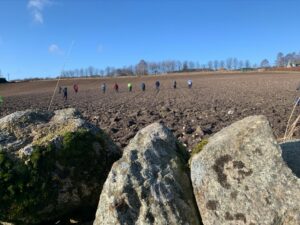
I’ve been thinking about the significance of archaeological sites in connection with a project I’m working on just now. I’m concerned in particular with lithic scatter sites: fields, or other areas, where a spread of worked stone is visible on the surface of the ground.
Some lithic scatter sites have many thousands of pieces of worked stone (usually, but not always, flint), but others may have only a few hundred, or even a handful. Some sites cover a wide area, some are smaller, some more concentrated. By classifying the types of worked stone found it is possible to get an idea of the chronological periods represented. The fashion for some things was, thankfully, different in the Mesolithic to the Neolithic and so on. Arrowheads are particularly vulnerable to fashion. The range of pieces can also provide a rough idea of activity: whether there is debris from the manufacture of tools for example, or perhaps mainly points, blades or scrapers left from the completion of some tasks. It is very rough and really, in order to understand any site better, some sort of more invasive archaeology is necessary to investigate the preservation of in situ features and other material. But often the collection and classification of a surface assemblage is the best way to obtain a basic understanding of the archaeology.
What bothers me, however, is how to assess the significance of these places? In the past we have tended to judge them by size and, where present, date. Big sites, with lots of material, would be regarded as more significant than small sites with only a few pieces. Sites with pieces that relate to earlier or less well-known periods also tend to be regarded as significant. But this is all very crude.
For starters, it is patently, only a register of the significance of a site in the present day. We are assessing the significance to modern archaeologists. Is it not, in fact, an unreliable evaluation to base the significance of a site in prehistory on the amount of debris that people left behind? By that measure the most significant places in post-war Britain would be old landfill sites. Weird (or maybe not).
Size may come into it, but it is a complex equation. Occupation sites generally contain a diversity of evidence: traces of shelters, hearths, storage, and waste. Our homes are certainly significant. But are they the most significant places in our lives? What about the wooded hillock a mile away where we know we can always be sure of bagging some game for the pot? What about the crystal-clear waterfall that leads to the burn running past our fields? It ensures life-giving fresh water throughout the year. What about the farm where we grew up, where our sister still lives with her family – we have never returned but it is always in our hearts. How about the tombs of the ancestors? The great oak where everyone congregates when we need to gather? You get my gist. One thing about our 2020 lockdown – it has changed the way we view the places on which we rely. Significance is not stable.
Some archaeologists are lucky. They have records, or even informants, to discuss the way in which the landscape worked for other communities. Opportunities like this open up new worlds, new interpretations. But they don’t exist for those of us concerned with the early Prehistory of Europe. The life of an archaeologist is devoted to interpreting other communities, but, of necessity, our first-hand experience is always limited to ourselves.
It occurs to me that we are wrong to dismiss the teeny-weeny lithic scatters as insignificant. We cannot ever know. While archaeologists focus on definable sites, the people of the past did not operate in discrete boxes; their behaviour took place across the landscape. There is, thus, a geographic gradation of detritus relating to any activity or life. Centres, known as sites, are likely to contain the highest density of detritus (in this case lithic assemblages), but it is unlikely to stop completely between centres. In order to understand human behaviour, therefore, it is important to record and investigate the less prolific areas of lithic material as well as the higher density spreads. This has long been an issue for archaeologists, and it is, of course, complicated by the geomorphological and other taphonomic processes that also impact on archaeological survival. Foley considered it, very eloquently, in 1978. Archaeology focusses on clearly defined sites with large numbers of finds, but those with fewer finds are likely to be just as interesting (and significant) in terms of ancient human behaviour. How to investigate and interpret the less clearly defined site, where a handful of lithics may be the only indication of prehistoric activity, is more of a problem, but we can, at least, record them and make a start.
Higher density sites may be significant in terms of archaeological resource and past human behaviour, but it is perhaps through examination of lower density sites that archaeological fieldwalking really comes into its own. In this way it offers a real contribution towards interpretation of the behaviour of the prehistoric communities. These are the places through which people passed: the routeways, overnight stops, hunting blinds, kill-site butchery areas, all the little everyday places that completed the web of human activity.
Without the small, and apparently insignificant, as well as the large, our archaeologies will always be incomplete.
You must be logged in to post a comment.